Illinois is located in the midwestern part of the United States and is famous mainly for Chicago, its largest city. The region is home to numerous animal species, the most common being the white-tailed deer, which is also the state animal of Illinois. The northern cardinal is Illinois’ state bird, and the monarch butterfly is the state insect.
Before some of Illinois’ modern animal species appeared, the territory was home to many prehistoric animals. Illinois’ fossil record starts from the Paleozoic Era, when the state was covered by water and inhabited by clams, corals, sea snails, and trilobites, among many other marine species. The state has a pretty impressive trilobite fossil collection!
While there isn’t much to say about Mesozoic and Pleistocene fauna in Illinois, archeologists discovered numerous fossils dating from the Ice Age. During that period, what we now call Illinois was inhabited by mammoths, mastodons, giant beavers, and other animals alike. In 1989, the Tully monster became Illinois’ state fossil. This animal species is endemic to the region.
1. Carolina parakeet
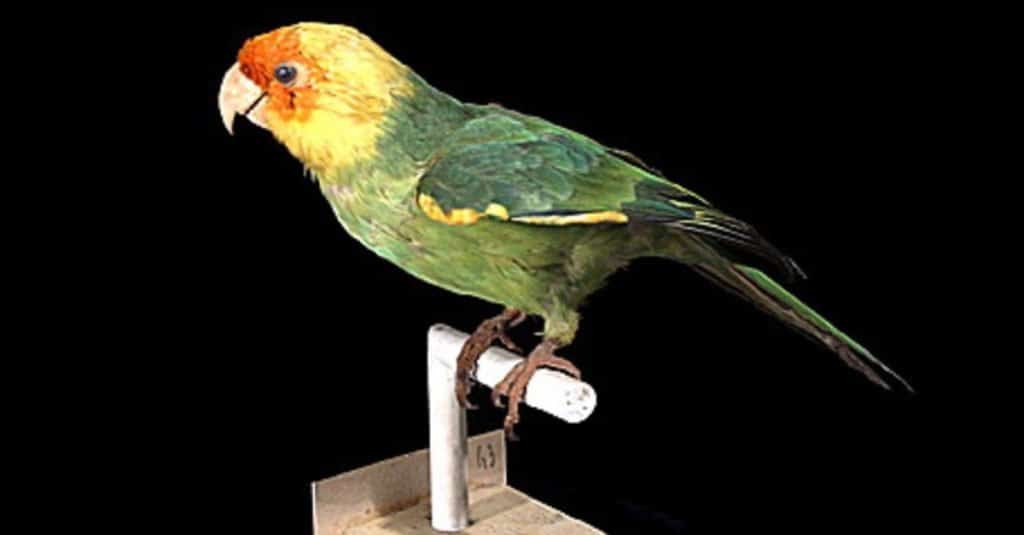
The Carolina parakeet slowly started to disappear in the 19th century.
©Naturalis Biodiversity Center / CC BY-SA 3.0 – License
| Carolina parakeet | |
|---|---|
| Kingdom | Animalia |
| Phylum | Chordata |
| Class | Aves |
| Order | Psittaciformes |
| Family | Psittacidae |
| Tribe | Arini |
| Genus | Conuropsis |
| Species | Conuropsis carolinensis |
| Extinct since | 1939 |
The Carolina parakeet, or Carolina conure, was a neotropical parrot declared extinct in 1939. It was one of the three parrots native to the United States, along with the green parakeet, which is still alive, and the thick-billed parrot, which is now endangered. These parrots looked similar to the jenday parakeet. The Carolina parakeet’s head and shoulders were bright yellow with orange spots on the forehead, extending behind the eyes. The rest of the body was covered in shades of green. Carolina conures weighed approximately 3.5 oz. and grew to 13 inches long.
The first Carolina parakeet references date from 1583. They slowly started to disappear in the 19th century. People last saw this bird in the wild in 1910. At the time, a Carolina parakeet held in captivity was still alive and living at the Cincinnati Zoo. In 1918, after it had died, authorities proceeded with the process of declaring it extinct.
2. Passenger pigeon
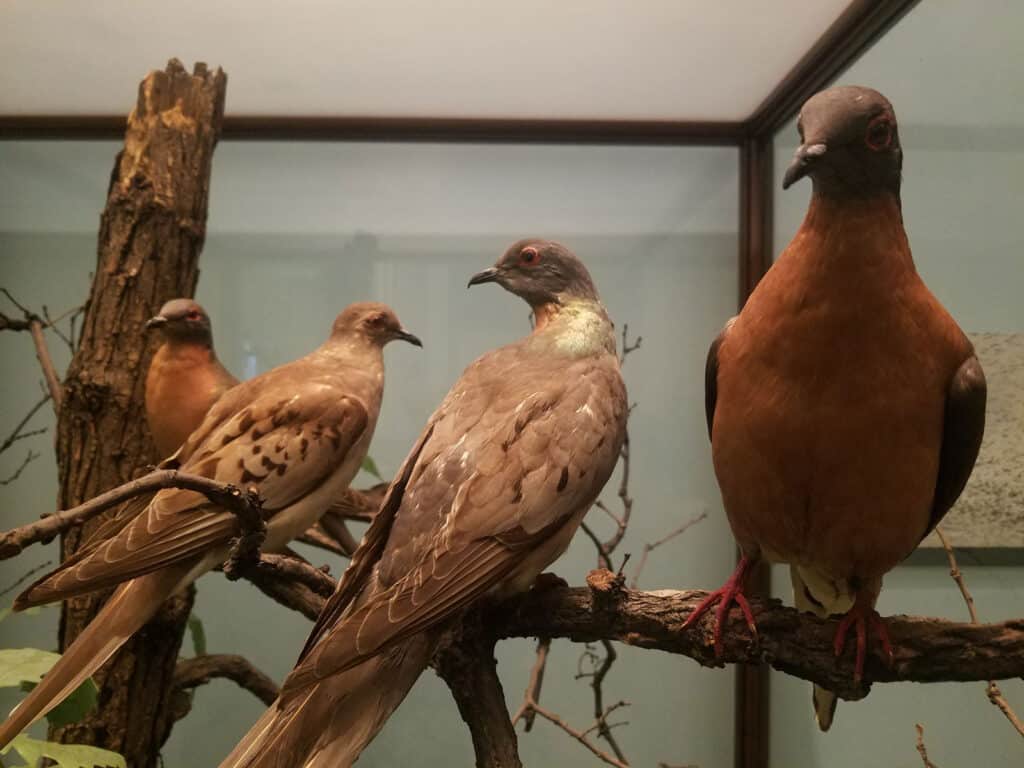
The oldest passenger pigeon fossil dates from approximately 5.3–3.6 million years ago.
©ChicagoPhotographer/Shutterstock.com
| Passenger pigeon | |
|---|---|
| Kingdom | Animalia |
| Phylum | Chordata |
| Class | Aves |
| Order | Columbiformes |
| Family | Columbidae |
| Genus | Ectopistes |
| Species | Ectopistes migratorius |
| Extinct since | 1914 |
The passenger pigeon was a pigeon species endemic to North America. The male pigeons measured 15.4–16.1 inches long and had lighter color patterns, while the female measured 15–15.7 inches long and had browner color shades. They are considered closely related to mourning doves and Zenaida doves.
The oldest passenger pigeon fossil dates from approximately 5.3–3.6 million years ago, indicating that these pigeons appeared during the Zanclean stage of the Pliocene. They were seen in Illinois, especially in the northern part of the state, until the end of the 19th century. Overall, the number of living passenger pigeons started to decline in the 1800s, and the most significant drop was registered between 1870 and 1890. The last passenger pigeon alive was in captivity at the Cincinnati Zoo and died in 1914.
3. Giant beaver
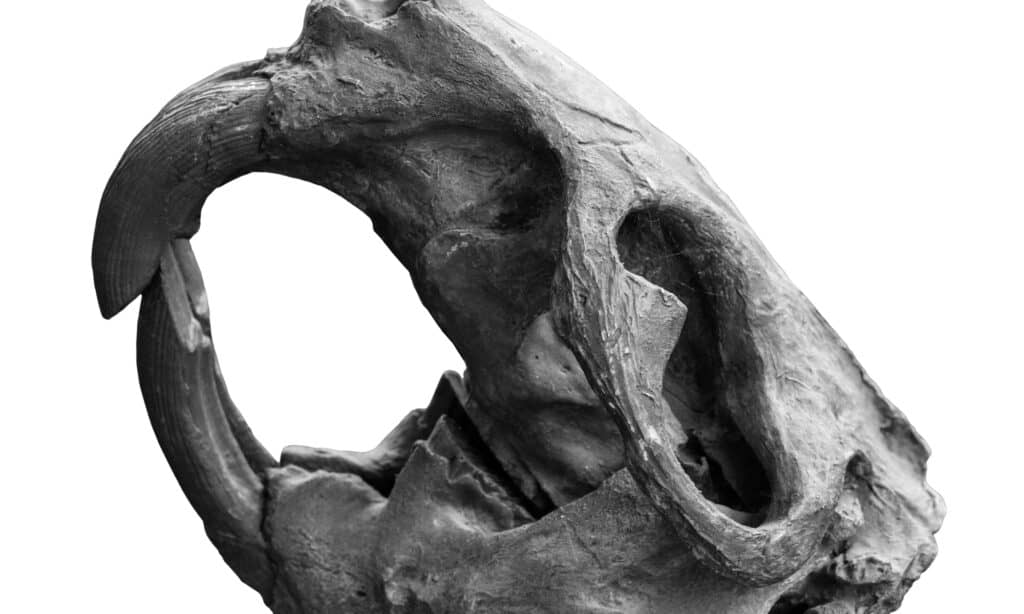
Giant beavers measured 6.2-7.2 feet long.
©Art_rich/Shutterstock.com
| Giant beaver | |
|---|---|
| Kingdom | Animalia |
| Phylum | Chordata |
| Class | Mammalia |
| Order | Rodentia |
| Family | Castoridae |
| Subfamily | Castoroidinae |
| Tribe | Castoroidini |
| Genus | Castoroides |
| Living period | Pleistocene period; went extinct 12,800-11,500 years ago |
The scientific name for giant beavers is Castoroides. Giant beavers measured 6.2 to 7.2 feet long. They weighed between 198 and 276 pounds. Besides being much larger than modern beavers, another unique characteristic sets the two apart – the giant beaver’s brain was smaller.
There were two types of giant beavers:
- Castoroides ohionesis, which lived throughout the United States and Canada;
- Castoroides dilophidus, which lived in the Southeastern United States.
Giant beavers lived in North America during the Pleistocene period. They inhabited Illinois during the Ice Age, when the territory was subject to glacial activity. Other U.S. states where giant beaver fossils were found include Indiana, Alaska, and Florida.
They disappeared 12,800–11,500 years ago, during the transition between the Pleistocene and the Holocene. Many scientists link this mass extinction to the arrival of the Clovis people, but there’s no substantial evidence. Other animals that went extinct during that period included mammoths, steppe bison, and mastodons.
4. Mammoth
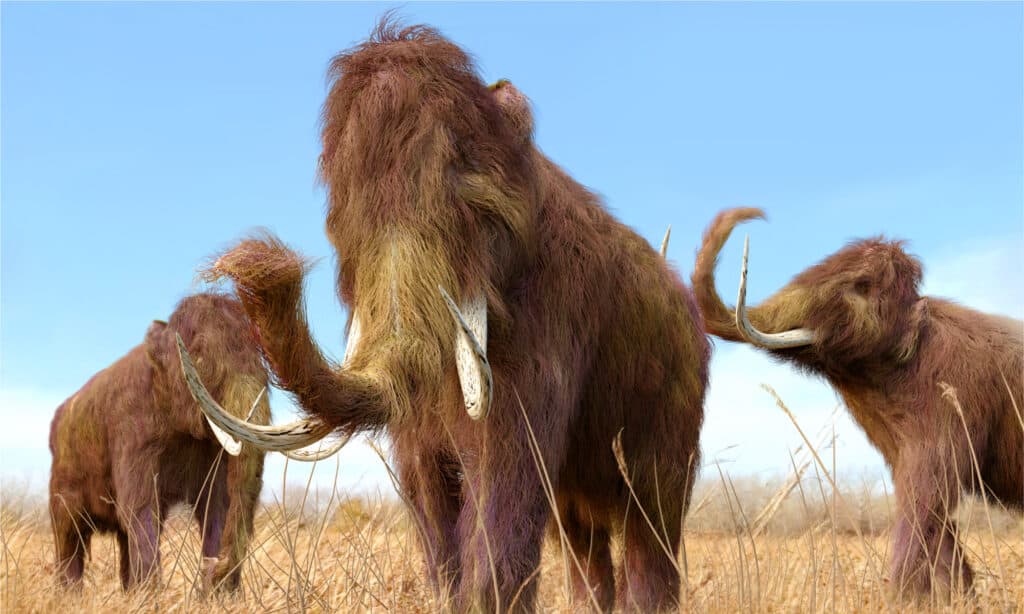
Mammoths were
elephant
-like mammals that lived from the Pliocene until the Holocene epoch.
©Aunt Spray/Shutterstock.com
| Mammoth | |
|---|---|
| Kingdom | Animalia |
| Phylum | Chordata |
| Class | Mammalia |
| Order | Proboscidea |
| Family | Elephantidae |
| Subfamily | Elephantinae |
| Tribe | Elephantini |
| Genus | Mammuthus |
| Living period | Pliocene – Holocene epochs |
Mammoths were elephant-like mammals that lived from the Pliocene until the Holocene epoch. The oldest mammoth in the world is the South African mammoth, which appeared 5 million years ago. Later, other mammoths moved to the north, inhabiting much of what we now call Eurasia. They only reached the North and South American continents approximately 600,000 years ago.
In 1977, on the 21st of June, Gary Jones, a worker at the Dupage Forest Preserve District in Wheaton, Illinois, handling heavy equipment, was assigned to work at Blackwell Forest Preserve. That day, he discovered some large bones in the preserve. On June 25-26, over 4,000 people came to see the fossil site. Archeologists worked hard for several weeks to recover the specimens.
The results of the Illinois Geological Survey showed that the bones were approximately 13,130 years old. Further investigations revealed that the bones belonged to a woolly mammoth. The remains are displayed at the Fullersburg Woods Nature Education Center in Oak Brook.
5. Stag-moose
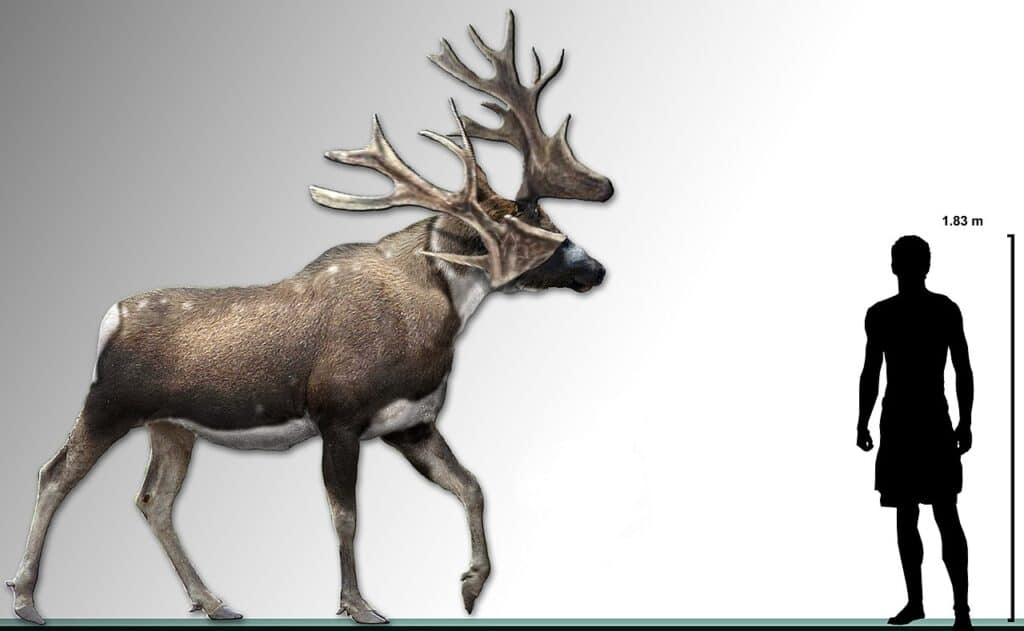
The stag-moose was a large deer that lived during the Late Pleistocene epoch.
©Dantheman9758 at English Wikipedia / CC BY 3.0 – License
| Stag-moose | |
|---|---|
| Kingdom | Animalia |
| Phylum | Chordata |
| Class | Mammalia |
| Order | Artiodactyla |
| Family | Cervidae |
| Subfamily | Capreolinae |
| Genus | Cervalces |
| Species | Cervalces scotti |
| Living period | Late Pleistocene epoch; went extinct 11,500 years ago. |
The stag-moose is also called an elk-moose. Its scientific name is Cervalces scotti. The stag-moose was a large deer that lived during the Late Pleistocene epoch. It was about the same size as a moose, measuring 8.2 feet long and weighing 1,562 pounds, and had an elk-like head and long legs.
The elk-moose lived in North America. These deer lived in Illinois during the Ice Age. They disappeared after a mass extinction approximately 11,500 years ago, along with other animals, such as mammoths, ground sloths, and saber-tooth cats.
6. Tullimonstrum
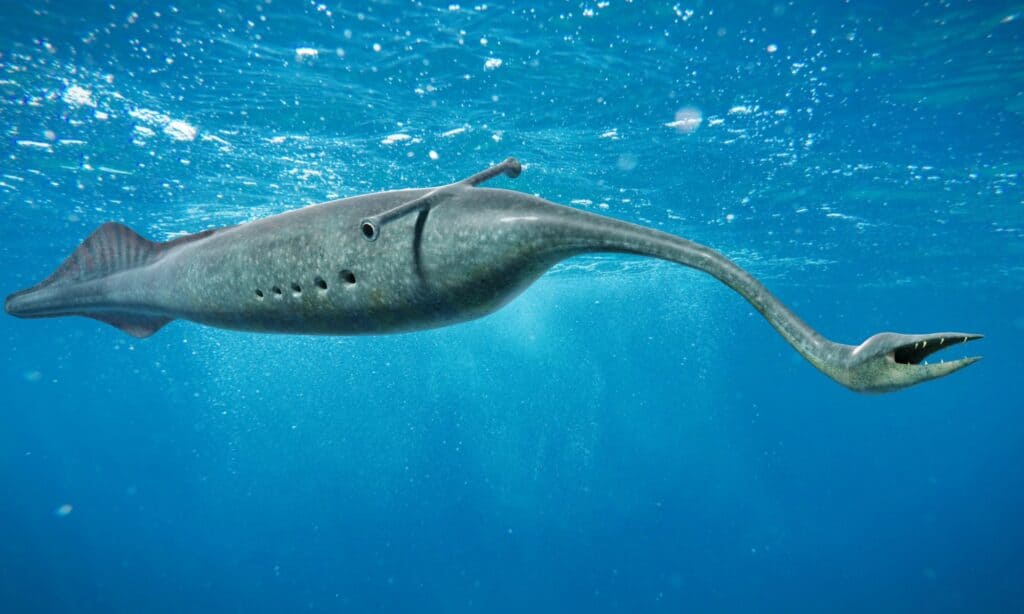
Tully monsters had two stalked eyes, just like snails, and their bodies were shaped like cigars.
©iStock.com/dottedhippo
| Tullimonstrum | |
|---|---|
| Kingdom | Animalia |
| Clade | Incertae sedis |
| Genus | Tullimonstrum |
| Living period | Pennsylvanian period, about 300 million years ago |
The Tully monster, or the Tullimonstrum, was a soft-bodied bilaterian animal, which means it had bilateral symmetry and no skeleton. Tully monsters had two stalked eyes, just like snails, and their bodies were shaped like cigars. The biggest Tullimonstrum grew as large as 14 inches, while the smallest was only 3.1 inches.
The classification of this animal raised many debates in the United States, as scientists couldn’t decide whether it was a vertebrate or an invertebrate. There were multiple studies in favor of both.
The Tully monster lived in what we now call Illinois when the territory was full of muddy estuaries and marine environments.
In Illinois, the Tullimonstrum fossils were discovered in the 1950s by Francis Tully. In 1989, the Tully monster became Illinois’ state fossil.
The photo featured at the top of this post is © Aunt Spray/Shutterstock.com
Thank you for reading! Have some feedback for us? Contact the AZ Animals editorial team.






